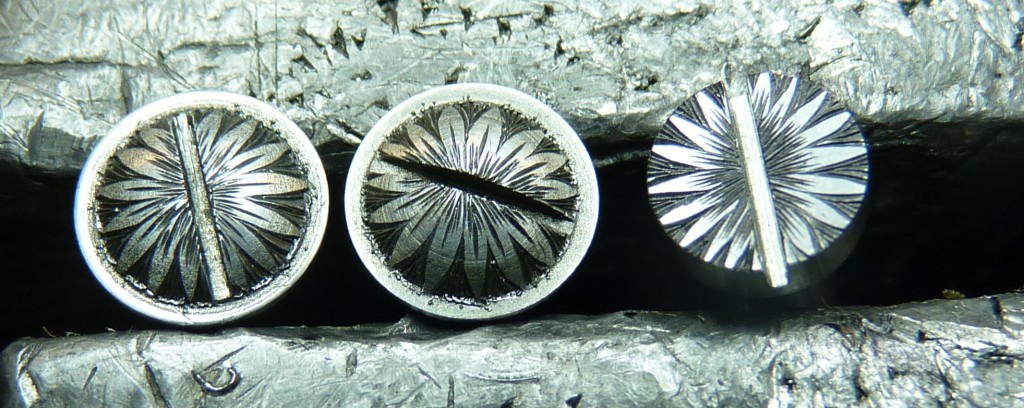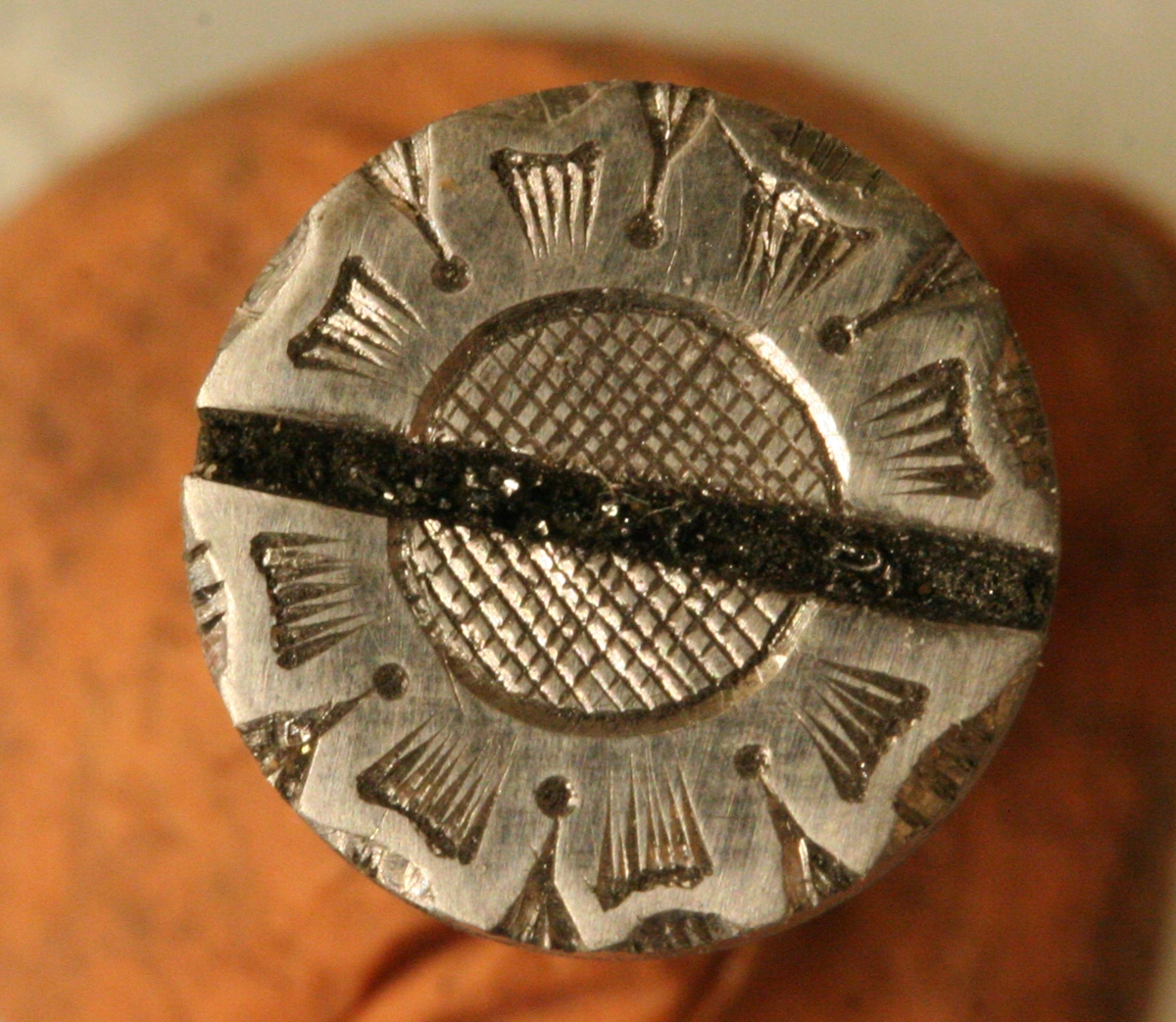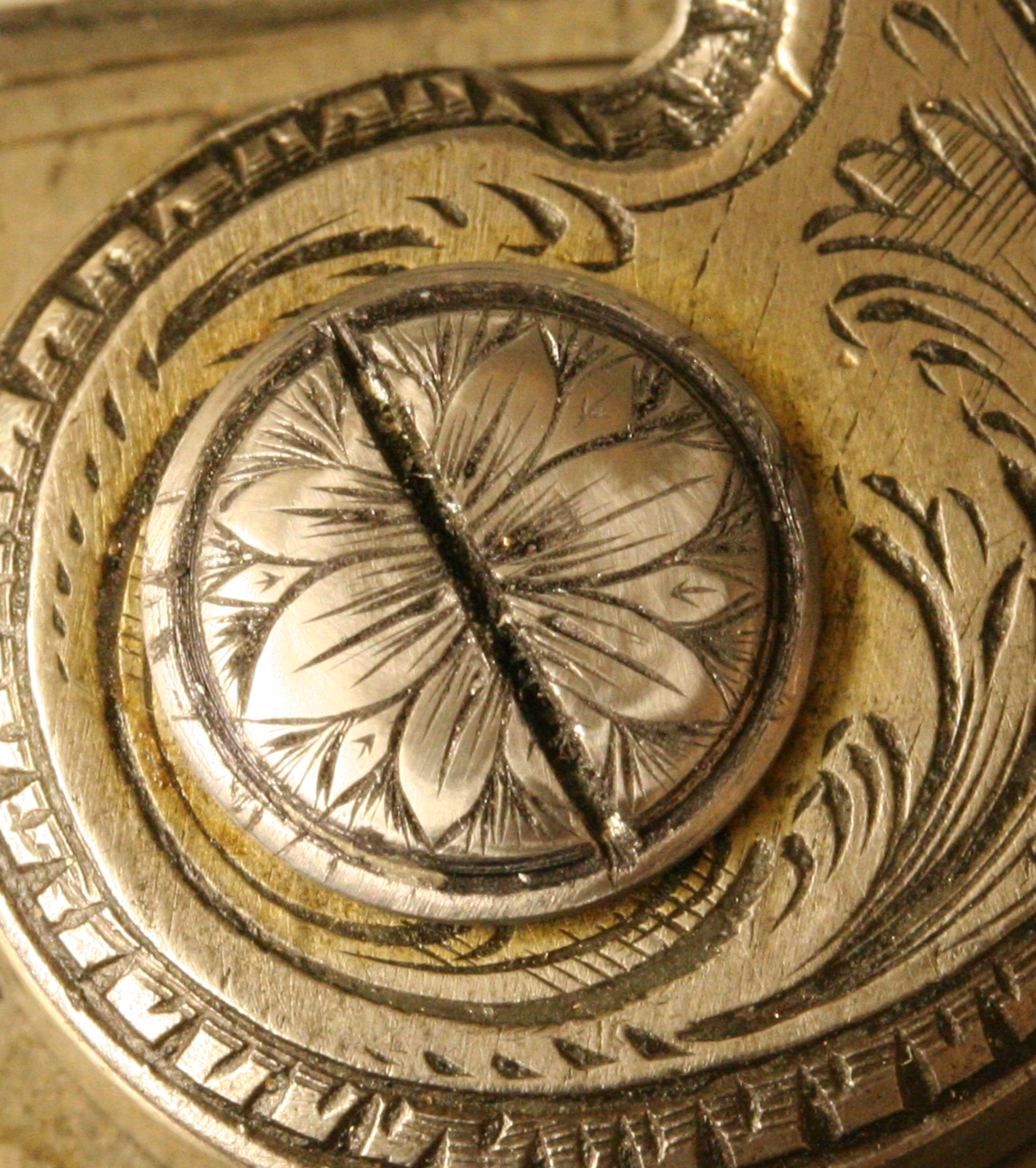\
For more photo examples see Engraved Screw Heads – Gallery post on this site.
For a list of dimensions of most modern thread sizes click here;- Useful thread Data
Gun screws are one of the most common things that get lost, broken or mangled on old guns and so are often remade. On an old gun a replaced screw that hasn’t been engraved stands out a mile, yet they are one of the easiest things to engrave, as we shall see…
Gun screws/nails, especially antique gun screws, fall into two types – screws that are fitted to the profile of the part they are fixing, like most screws holding the furniture – tangs, trigger guards, butt plates etc. which are usually countersunk, and those that don’t need to be individually filed to match – usually the side screws and cock screws. Obviously the latter are by far the easiest to replace, which is fortunate as its the lock screw that is used most often and therefore most prone to damage or loss. Military firearms were made with the minimum number of fitted screws for economy of effort and mostly didn’t worry about the slot alignment.
Fitted screws need to have the countersunk angle exactly right to fit well, and must be made in an iterative process that allows the final slot to be cut in exactly the right alignment – conspicuous gun screws always have the slot aligned along the gun. To do this you need to make the screw with a tall head, and put a temporary slot in it so that you can tighten the screw up to almost the final tension – then mark the alignment of the slot (making an allowance of maybe 5 or 10 degrees for final tightening) before carefully filing off the temporary slot and cutting a starting narrow slot in teh correct alignment then filing the profile on the top of the screw – which you will have to do out of the gun and keep fitting it and removing it and modifying the slot as you go….. obviously the gunmaker filed the part and the screw together ‘in the white’ and therefore had an easier job. I often make a long neck on the screw with a head on top so I have bit of a platform to mark the final slot on. Hacksaws and knife edge files are not really suitable for cutting fine screwdriver slots in the heads of gun screws, which were often somewhat tapered, almost to a V at the bottom. I have a set of bits of 12 inch hacksaw blades that I’ve ground down on a grinding wheel or a diamond ‘stone’ to get rid of the wavy set and shape the edge to the desired V – they obviously don’t cut as well as they did, but with a bit of effort will cut a good slot – the trick is to get it in the middle of the head!
The other end of the screw you are making may or may not be easily sorted. I find that a set of UNF and UNC dies will usually provide a matching thread for British guns post about 1850 and often earlier, and if you have B.A. and Metric too you can often find a match using a thread gauge and a magnifying glass. If you don’t have the screw – just the hole then shave down a wooden peg and screw that in to make an imprint of the thread to measure. An alternative for side screws and long screws with a parallel section where the thread is still OK is to make a new head section and splice it onto the old thread with a TIG weld. The worst case scenario is having to screwcut an odd thread in the lathe. I have avoided that on occasions by ‘modifying a die to cut a larger diameter by opening it out, which usually cracks it but it still works – I guess running a TIG welder down the die might soften it a bit.
It is theoretically possible to make a new screw without a lathe, but not something I have done! Obviously replacement fitted screws can’t be made without the gun to which they need to be fitted.
There are a number of more or less standard patterns of engraving on screw heads – some are MUCH easier to engrave than others and make a good first project. I often engrave screws when I’m doing demonstrations as it is very quick and doesn’t require much concentration! The easiest patterns to use are like the third one in the photo below – they are very easy because all the deep cuts run off the edge of the screw, so no problems with slips, and as long as you don’t stick the graver in your finger you can’t come to much trouble! When engraving screws it pays to hold the screw in lead lined jaws because then you can run the graver off the edge of the screw as you take out the gaps between the petals etc. you won’t damage the graver on hard metal. After engraving a few screw heads I have a very mangled set of jaw liners! Screw heads were usually engraved in a very quick, almost perfunctory fashion as the visual effect is got from a simple design and they are not usually looked at in detail – its a good test piece – I’d recommend a beginner buying some traditional steel woodscrews in size 12 or 10 from ebay and preparing the heads in an electric drill, pressing down on 320 grade paper on a slightly resilient surface. The slots are of course far too gross for use in guns, but they are cheap and good practice pieces.
A small job for a fellow Anglian Muzzle Loader (See LINKS) – engraving a set of screws (nails) for his very smart double flintlock.
They have been polished, engraved, case hardened ( Blackley Colour case hardening powder – see LINKS) and tempered dark straw on the hotplate of the Aga and lightly polished with very worn 3000 grade paper.
Two Cock nails and a side nail
This is a eplacement small screw for a modern gun that was engraved by Geoff Moore
Replacement cock screw for a Joe Manton conversion of one of his flintlocks to percussion
SEE THE POST ENGRAVED SCREW HEADS – GALLERY FOR MORE PHOTOS



Hello, i have an ~1850 W&C Scott & Son 12-gauge shotgun that is missing an engraved screw from one of the hammers. Is it possible to get one made or locate a replacement? I can send photos. I’ve done a little research and believe the screw is some type of Whitworth thread. I live in the Bay Area, California.
Thanks for your time.
Hi, Should be perfectly possible to make a new screw – I’m not sure that it would be a Whitworth thread in such a small diameter – more likely to be a BSF or its near equevalent UNF. You might try with a few small UNF screws that you can get in the States – No 4, 5 or 6 might fit, I find that they often work. If you can find a screw that fits its much easier to make the final screw as the thread can be cut with a die – its difficult to cut small threads on a lathe. Once the thread is identified, making the screw and engraving it is easy. If you have access to a thread gauge, you can screw a matchstick or equivalent into the hole and measure the pitch of the thread that is ‘cut’ on it. I have dies for UNF, ISO metric and B.A. and can usually find something that works if I have the gun here. If you gun is W & C Scott and Son then I think it was made after 1858 when the sons joined the business, so its quite late for a percussion gun – they were making top quality guns then! Do send me a photo, see Contact for my email address.
Thanks for your interest.
Tim